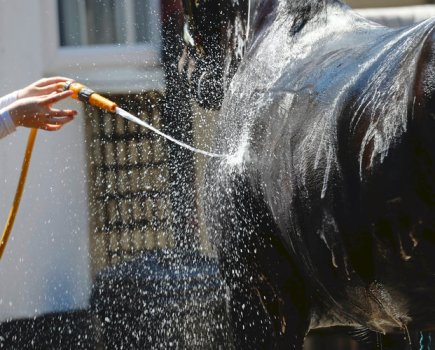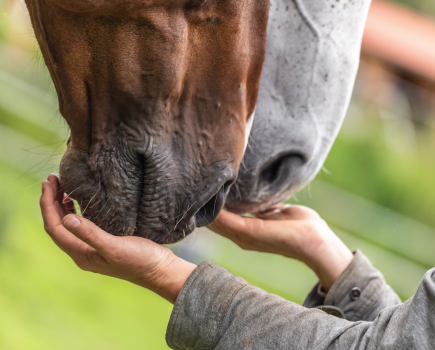In partnership with SPILLERS™
Horse feed balancers are small, nutrient dense feeds (normally pellets), designed to provide a concentrated supply of vitamins, minerals and amino acids (quality protein), to provide a well-rounded horse diet. Due to the low feeding rate – typically 500g per day for a 500kg horse on a forage only diet – they contribute minimal calories, starch and sugar to the diet, making them ideal for good doers and suitable for laminitics too.
Although they can be fed on their own, feeding your balancer alongside a small amount of low calorie chaff or mash will help to bulk out the bucket and slow eating time.
15 facts about balancers
Cutting calories is essential for weight loss but shouldn’t come at the expense of providing a balanced diet. Here’s 15 facts to help explain why horse feed balancers are ideal for good doers and help you choose which balancer may be most suitable for your horse.
- Forage can easily exceed calorie requirements for many horses but may fall short of key nutrients including copper, zinc, selenium, vitamin E and lysine (an essential amino acid).
- The recommended amount of balancer provides just 6% (approximately) of the published daily energy (calorie) requirement for a horse in light work – approximately 5-6 times less than the recommended amount of low calorie mix or cubes!
- Lite balancers are not significantly lower in calories than any other balancer when fed at the recommended amount (stud balancers are an exception to this rule). However, some ‘lite balancers’ may have additional benefits to offer and are specifically formulated to balance a calorie restricted diet (see facts 4 and 5 for more tips).
- If your horse is on restricted forage/ grazing, has soaked hay or fed straw as a partial forage replacer, look for balancers high in lysine and vitamin E as intake of these key nutrients may be particularly low in horses/ ponies on a calorie restricted diet.
- If your horse is prone to piling on the pounds, consider balancers without probiotic live yeast. Live yeast may help to improve fibre digestion in the hindgut and while this might sound like a good thing, improving digestive
efficiency yields more calories! In fact, recent research found that in weight loss resistant ponies, microflora involved in fibre digestion may adapt to become more prevalent/ more efficient! - Avoid balancers (and other feeds and supplements) containing added iron. Iron deficiency in horses is extremely rare and forage typically exceeds requirements, even in horses fed restricted rations. As Iron is also one of the few minerals that can be harmful at relatively low levels, it’s sensible to avoid any unnecessary excess intake.
- Due to the low feeding rate, balancers provide minimal amounts of starch and sugar per daily serving, making them suitable for laminitics and those prone to excitability. If your horse/ pony is severely insulin dysregulated, it may be helpful to divide the recommended daily amount into multiple meals – contact a nutrition advisor for specific advice.
- Most pelleted feed balancers are designed to be fed at rate of 100g per 100kg of bodyweight per day – 500g per day for a 500kg horse. Although the feeding rate for stud balancers is higher than ‘regular’ balancers (due to high level of amino acids required for foetal development, lactation and growth), they are still significantly lower in calories than traditional stud feeds per daily serving.
- If feeding a balancer alongside another feed containing added vitamins and minerals reduce the amount accordingly. For example, feeding half the recommended amount of balancer alongside half the recommended amount of compound feed generally works well (provided the additional calories provided by the compound feed are needed!).
- Choose a stud balancer for mares in late gestation and during lactation, foals, yearlings and breeding stallions. Changes in feed are generally unnecessary for mares in early gestation (provided they don’t have a foal at foot) and stallions only covering 2 or 3 mares per season provided their diet is already balanced and they are maintaining a healthy body condition.
- Balancers provide amino acids (the ‘building blocks’ which make up protein) such as lysine whereas vitamin and mineral supplements contain very few if any amino acids. Remember this is important because forage only diets may fall short of quality protein, not just vitamins and minerals.
- Pelleted feed balancers can be fed on their own (unlike powdered supplements) but adding a low-calorie chaff to the bucket is a great way of helping to extend eating time and ‘bulking out the bucket’ while adding minimal calories to the diet.
- Although it’s true pelleted balancers provide more calories, the difference this makes to the overall diet is negligible in most cases, especially for those with access to grazing.
- Many balancers contain added functional ingredients such as joint or digestive support. When choosing a balancer, consider which, if any of these may be of most benefit to your horse. If you’re simply looking for essential nutrients to balance forage, look for a balancer without the added bells and whistles.
- A bag of balancer will typically last a 500kg horse 4-6 weeks (depending on whether it’s a 15kg or 20kg bag), so although the price per bag may seem high, the low daily feeding rate makes balancers a cost-effective solution for good doers.
For more help or advice contact the SPILLERS Care-Line on 01908 226626 or visit spillers-feeds.com
![]() Have you heard about Your Horse’s #FitNotFat campaign? Equine obesity is an enormous welfare problem and we’re on a mission to provide owners and riders with the knowledge, skills and information you need to keep your horse in tip-top health. It could be life saving! Find out more
Have you heard about Your Horse’s #FitNotFat campaign? Equine obesity is an enormous welfare problem and we’re on a mission to provide owners and riders with the knowledge, skills and information you need to keep your horse in tip-top health. It could be life saving! Find out more
Lead image: copyright Shutterstock









